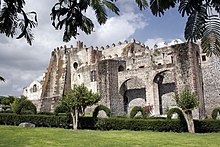
Back الكنيسة الكاثوليكية وعصر الاستكشاف Arabic Iglesia católica y la Era de los Descubrimientos Spanish Gereja Katolik dan Zaman Penjelajahan ID

The Catholic Church during the Age of Discovery inaugurated a major effort to spread Christianity in the New World and to convert the indigenous peoples of the Americas and other indigenous peoples. The evangelical effort was a major part of, and a justification for, the military conquests of European powers such as Portugal, Spain, and France. Christian missions to the indigenous peoples ran hand-in-hand with the colonial efforts of Catholic nations. In the Americas and other colonies in Asia, and Africa, most missions were run by religious orders such as the Franciscans, Dominicans, Augustinians, and Jesuits. In Mexico, the early systematic evangelization by mendicants came to be known as the "Spiritual Conquest of Mexico".[1]
Antonio de Montesinos, a Dominican friar on the island of Hispaniola, was the first member of the clergy to publicly denounce all forms of enslavement and oppression of the indigenous peoples of the Americas.[2] Theologians such as Francisco de Vitoria and Bartolomé de las Casas drew up theological and philosophical bases for the defense of the human rights of the colonized native populations, thus creating the basis of international law, regulating the relationships between nations.[3] Important contemporary ecclesiastical documents taking a strong stance on enslaving or despoiling the indigenous peoples of the Americas was the ecclesiastical letter Pastorale officium and the superseding encyclical Sublimis Deus.
In the early years, most mission work was undertaken by the religious orders. Over time it was intended that a normal church structure would be established in the mission areas. The process began with the formation of special jurisdictions, known as apostolic prefectures and apostolic vicariates. These developing churches eventually graduated to regular diocesan status with the appointment of a local bishop. After decolonization, this process increased in pace as church structures altered to reflect new political-administrative realities.
- ^ Robert Ricard, The Spiritual Conquest of Mexico: An Essay on the Apostolate and the Evangelizing Methods of the Mendicant Orders in New Spain: 1523–1572, translated from the French by Lesley Bird Simpson. Berkeley: University of California Press 1966. The original text in French, Conquête Spirituelle du Mexique appeared in 1933.
- ^ Hanke, Lewis. (1946) "Free Speech in Sixteenth-Century Spanish America". The Hispanic American Historical Review, 26,2:135–149. Page 142.
- ^ Hernandez, Bonar (2001). "The Las Casas-Sepülveda Controversy: 1550-1551" (PDF). history.sfsu.edu. Archived from the original (PDF) on 2020-11-12. Retrieved 2020-06-20.
© MMXXIII Rich X Search. We shall prevail. All rights reserved. Rich X Search